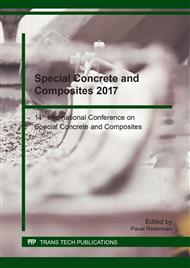p.108
p.114
p.119
p.127
p.132
p.141
p.147
p.152
p.158
The Effect of Temperature on the Fundamental Characteristics of Self-Compacting No-Cement Refractory Castable
Abstract:
In this research, the impact of firing temperature and MgO addition on mechanical and physical properties of self–compacting no-cement castables were investigated. For this propose up to 3.3 wt % of MgO was added to the corundum castable compositions and the specimens were fired at 600 °C, 800 °C, 1000°C, 1200°C and 1500°C. The mixtures were made so that the consistency of each one was the same. There were only minimal differences in the mixtures water content. The mineral composition of the input raw materials for manufacturing of the refractory castables was determined. The physical and mechanical properties of castable compositions such as self-flow values, bulk density, apparent porosity, cold crushing strength and flexural strength were examined. Also, the X-ray diffraction (XRD) and scanning electron microscopy (SEM/EDX) techniques were used for detection the ceramic phase formation. The corrosion resistance was determined by means of the crucible test according to ČSN P CEN/TS 15418 (726022) Method of test for dense refractory products – Guidelines for testing the corrosion resistance of refractories caused by liquids. The study follows up on research, the results of which were published last year [1], but the study is focused to self-compacting refractory castable.
Info:
Periodical:
Pages:
132-138
Citation:
Online since:
January 2018
Authors:
Price:
Сopyright:
© 2018 Trans Tech Publications Ltd. All Rights Reserved
Share:
Citation:


